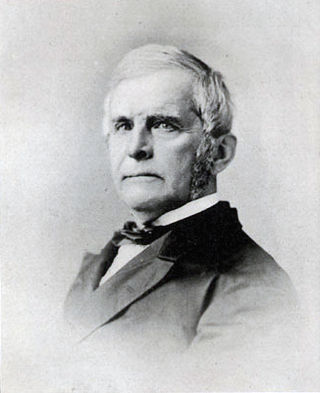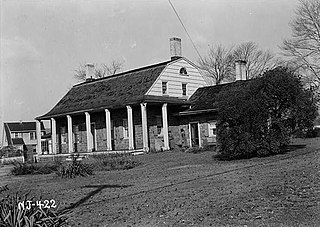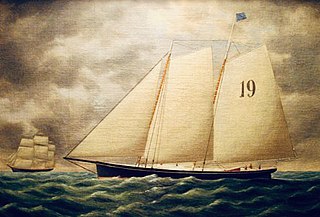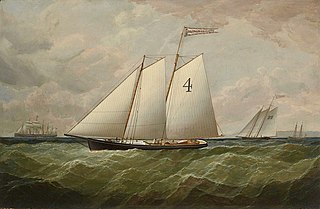See also
- William Westerfeld House, in San Francisco, California
Westervelt House is a historic house in Tenafly, New Jersey.
Westervelt House may also refer to:

Tenafly is a borough in Bergen County, in the U.S. state of New Jersey. As of the 2020 United States census, the borough's population was 15,409, an increase of 921 (+6.4%) from the 2010 census count of 14,488, which in turn reflected an increase of 682 (+4.9%) from the 13,806 counted in the 2000 census. Tenafly is a suburb of New York City.

Jacob Aaron Westervelt was a renowned and prolific shipbuilder who constructed 247 vessels of all descriptions during his career of over 50 years. From 1853 until 1855 he was Mayor of New York City.
Westervelt is a surname. Notable people with the surname include:
Ridgefield Township was a township that existed in Bergen County, New Jersey. The township was created in 1871, when Hackensack Township was trisected to form Palisades Township in the northernmost third, Englewood Township in the central strip and Ridgefield Township encompassing the southernmost portion, stretching from the Hudson River on the east to the Hackensack River, with Hudson County to the south. Much of the area had been during the colonial area known as the English Neighborhood. As described in the 1882 book, History of Bergen and Passaic counties, New Jersey,
Ridgefield is the first township in Bergen County which the traveler enters in passing up the Palisades. His first impressions are much like those of old Hendrick Hudson in speaking of a wider extent of country: "A very good land to fall in with, and a pleasant land to see." The valley of the Hackensack invited early settlers in the seventeenth century, and the valley of the Overpeck Creek, a navigable arm of the Hackensack, also attracted settlers quite as early in this direction. Sloops and schooners can pass up this creek nearly to the northern boundary of the township. Ridgefield is bounded on the north by Englewood, on the east by the Hudson, on the south by Hudson County, and on the west by the Hackensack River. The southern boundary is less than two miles in extent, and the northern less than four, and the length of the township from north to south does not exceed four miles. Bellman's Creek, forming part of the southern boundary, the Hackensack, the Overpeck, the Hudson, with more than a dozen other smaller streams and rivulets, bountifully supply the whole township with water. From the western border of the Palisades the land descends to the Overpeck, forming a most beautiful valley, with the land again rising to a high ridge midway between the Overpeck and the Hackensack. From this long ridge, extending far to the north beyond this township, it took its name of Ridgefield.
The New York, Susquehanna and Western, formerly the Midland Railroad, the Jersey City and Albany Railroad, and the Northern Railway of New Jersey—all running northward through the township— afford ample railroad accommodations. The Susquehanna enters the township at Bellman's Creek, and the Northern at about one hundred feet south of the creek, and at a point north and east of the Susquehanna. The Albany road in this locality is not yet constructed, diverging at present from the track of the Susquehanna between Little Ferry and Bogota stations. It has, however, an independent line projected and now under construction to New York City.
Early Settlements. Ridgefield embraces the earliest settlements in the ancient township of Hackensack, antedating even the organization of that township in 1693, and of the county of Bergen in 1675. There seems to have been no town or village compactly built, like the village of Bergen, but there were settlements both of Dutch and English in and about what was subsequently known as English Neighborhood prior to 1675. The Westervelts, the Zimcrmans, the Bantas, and the Blauvelts, all coming from Holland, settled in the middle of the seventeenth century in that locality. The ancestors of Jacob P. Westervelt, now of Hackensack Village, with himself, were born in English Neighborhood. His father was born there in 1776, and was the son of Christopher Westervelt, who was born there certainly as early as 1690, and he was the son of the original ancestor of this family, who came from Holland and settled on Overpeck Creek, within the present limits of Ridgefield township, probably about 1670.

Ramsey Route 17 station is one of two railroad stations operated by New Jersey Transit in the borough of Ramsey, Bergen County, New Jersey, United States. Named after nearby Route 17, trains at the station are serviced by the Main Line and Bergen County Line, along with Metro-North Railroad's Port Jervis Line.

The Benjamin P. Westervelt House, located at 253 County Road in Cresskill, Bergen County, New Jersey, was the home of Benjamin P. Westervelt, a member of the local militia during the American Revolutionary War. The main wing of the Dutch Colonial-style house was built by Westervelt in 1808, but the Westervelt family has continuously occupied the site since at least 1778.
Jacob Westervelt was the Sheriff of New York County from 1831 to 1834. He was president of Lafayette Bank of New York City.
Jacob Westervelt may refer to:
The West End is the former name of the only neighborhood in Historic Downtown Jersey City, New Jersey that is entirely west of the New Jersey Turnpike's Newark Bay Extension.

The Peter Westervelt House and Barn is located at 290 Grand Avenue in Englewood, Bergen County, New Jersey. Built in 1808, the house was added to the National Register of Historic Places on March 19, 1975. The barn has since been demolished, and the house now forms part of a professional office development.

The Westervelt–Ackerson House is located in Ramsey, in Bergen County, New Jersey, United States. The house was added to the National Register of Historic Places on July 20, 1977.

Westervelt House is located in Tenafly, Bergen County, New Jersey, United States. The south wing of the house was built in 1745 by Roelof Westervelt whose grandfather purchased the property in 1695. The central section of the house was added in 1798 and later in 1825 the north wing was added. Ownership of the house remained in the hands of the Westervelt family until 1923. It serves as the oldest standing building in Tenafly. The house was added to the National Register of Historic Places on August 15, 1983.

The Westervelt–Cameron House is located at 26 East Glen Avenue in the village of Ridgewood in Bergen County, New Jersey, United States. The house was built around 1767 and was added to the National Register of Historic Places on January 10, 1983, for its significance in architecture and exploration/settlement. It was listed as part of the Early Stone Houses of Bergen County Multiple Property Submission (MPS).

Westervelt–Lydecker House is located in Woodcliff Lake, Bergen County, New Jersey, United States. The house was built in 1756 and was added to the National Register of Historic Places on January 10, 1983.

The Caspar Westervelt House is located in Teaneck, Bergen County, New Jersey, United States. The house was built in 1763 and was added to the National Register of Historic Places on January 10, 1983.

Jacob A. Westervelt was a 19th-century Sandy Hook pilot boat designed by naval architect John W. Griffiths and built by Jacob A. Westervelt in 1853. She was one of the fastest pilot-boats in the fleet. In 1858, while attempting to board the British steamer Saxonia she was fatally run into and sank outside of Sandy Hook. The Edmund Blunt, was built to replace her.

The Christian Bergh was a 19th-century Sandy Hook pilot boat built in 1851 at the Westervelt & Co. shipyard. She later became a Pennsylvania pilot boat until her service ended in 1886 when she became an oyster boat in the Delaware Bay. She was named after Christian Bergh a prominent shipbuilder in New York and a close friend of Jacob Westervelt.

The Abraham Leggett was a 19th-century New York pilot boat built by Daniel Westervelt at the Westervelt & Co. shipyard. She helped transport New York City maritime pilots between inbound or outbound ships coming into the New York Harbor. In 1866, Pilot Michael Murphy was on the Abraham Leggett when the bark Emilie ran into the pilot boat. In 1879, the Abraham Leggett was hit and sank by the steamship Naples from Liverpool. She was replaced by the pilot boat Alexander M. Lawrence.

Edmund Blunt was a 19th-century New York pilot boat built in 1858 by Edward F. Williams for the New York Pilots. She helped transport New York City maritime pilots between inbound or outbound ships coming into the New York Harbor. She survived the Great Blizzard of 1888. In the age of steam, the Blunt along with other pilot boats, were replaced with steamboats. She was built to replace the Jacob L. Westervelt, which sank in 1857.

The Garritse–Doremus–Westervelt House, also known as the Vanderhoef–Westervelt House, is a historic Dutch Colonial stone farmhouse located at 794 Park Drive in Weasel Brook Park in the city of Clifton in Passaic County, New Jersey, United States. It was documented by the Historic American Buildings Survey (HABS) in 1939 and was added to the National Register of Historic Places on March 20, 2023, for its significance in architecture. The c. 1785 house is one of the oldest in the county.